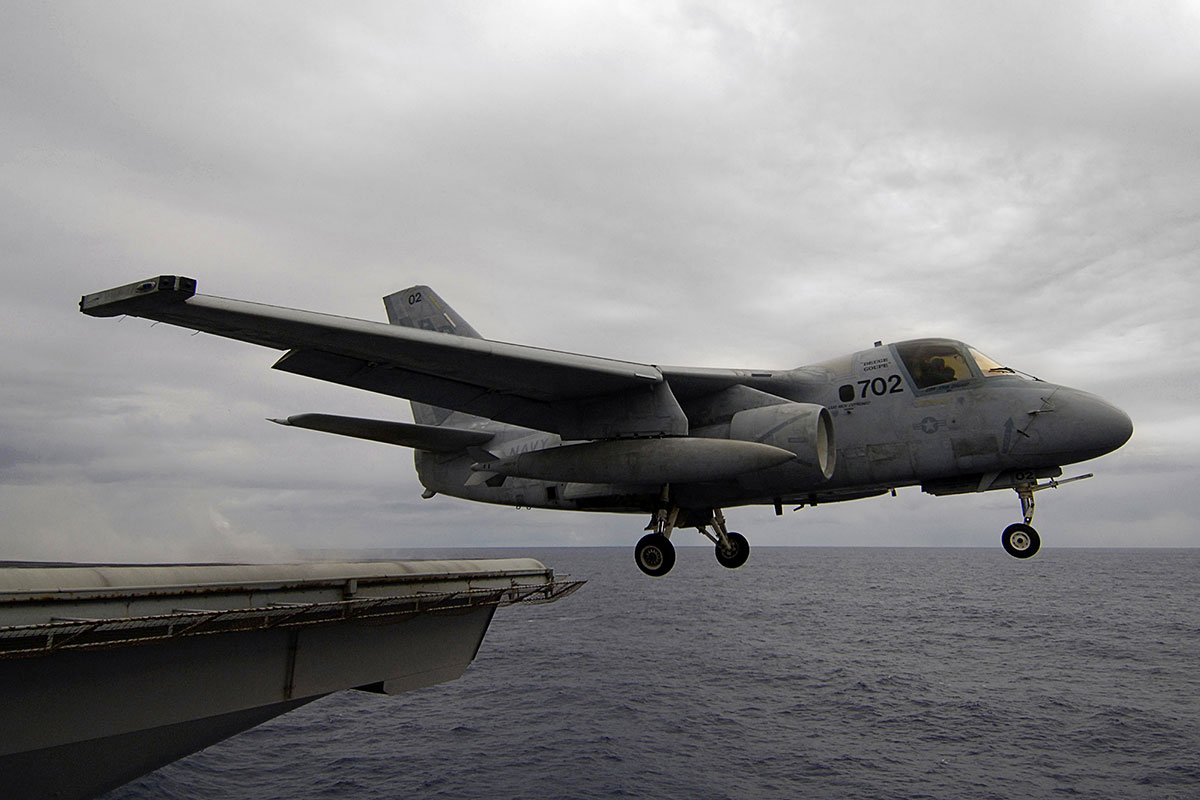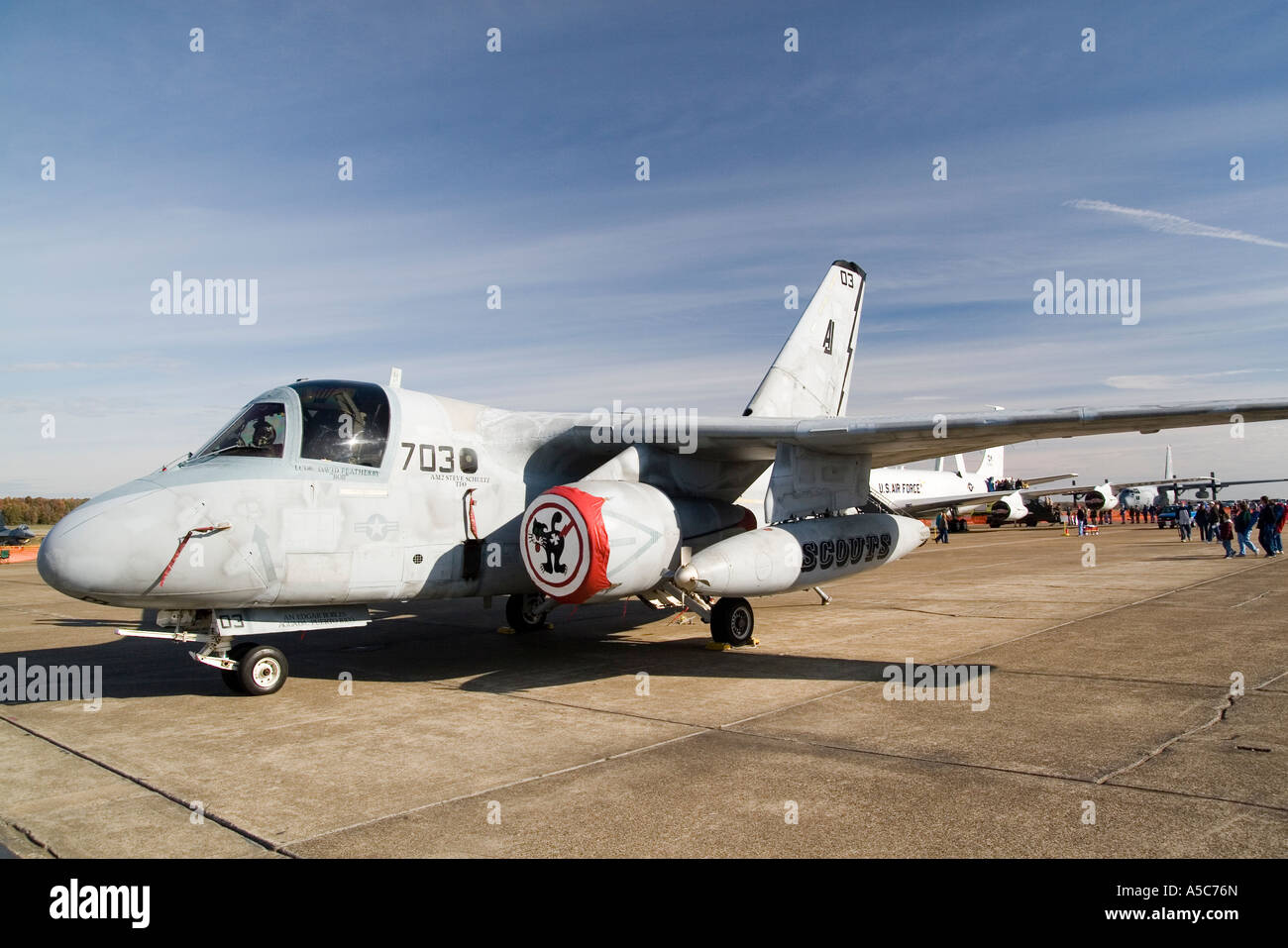Lockheed S-3 Viking - The Lockheed S-3 Viking is a four-seat, twin-engine turbofan jet aircraft designed and manufactured by the American aircraft manufacturer Lockheed Corporation. Because of its characteristic sound, it was named "War Hoover" after the vacuum cleaner brand.
The S-3 was developed in response to the United States Navy's (USN) VSX program to acquire a successor to the Grumman S-2 Tracker for anti-submarine warfare (ASW) aircraft. With Ling-Temco-Vought (LTV), it is designed to be a carrier-based subsonic, all-weather, long-range, multi-role aircraft.
Lockheed S-3 Viking

On January 21, 1972, the YS-3A prototype made its first flight of the type. After regular maintenance in February 1974, it proved to be a reliable workhorse. In the ASW role, the S-3 carried automatic weapons and in-flight refueling equipment. Additional variants such as the ES-3A Shadow carrier-based electronic intelligence (ELINT) platform and the US-3A carrier-based utility and cargo were introduced in the 1980s and 1990s. In the late 1990s, the S-3B mission transitioned to surface warfare and aerial refueling of carrier battle groups. They fought in the Gulf War in the early 1990s, the Yugoslav Wars in the mid-to-late 1990s, and the Afghanistan War in the 2000s.
The Last Viking Nasa's S 3b
In January 2009, the S-3 was withdrawn from front-line fleet aircraft carriers and replaced by the P-3C Orion, P-8 Poseidon, SH-60 Seahawk, and F/A-18E/F. Super Hornet. For more than a decade, a handful of S-3s were flown by the Thirty Air Test and Evaluation Squadron (VX-30) at Naval Air Station Vtura Area / NAS Point Mugu, California, to conduct range and surveillance operations at the NAVAIR Point Mugu Range. These last examples were withdrawn from US Navy service in early 2016. The last operational S-3 was operated by the National Aeronautics and Space Administration (NASA) at its Research Center in Gln until NASA retired it in mid-2021. The decommissioned S-3s at Mose were placed in storage while future options were explored. In the 2010s, Lockheed Martin proposed refurbishing it for delivery to shippers. The ROK Navy also planned to use refurbished S-3s for ASW; these plans were canceled in 2017.
In the mid-1960s, the United States Navy (USN) formulated the VSX (heavier-than-air, anti-submarine, experimental) requirement, seeking a dedicated anti-submarine aircraft capable of launching from its aircraft carriers. to the existing list of Grumman S-2 Trackers. The service issued a call for tenders to the industry. In August 1968, a team led by Lockheed and a competing team consisting of Convair and Grumman were asked to continue developing their proposals to meet this requirement.
At this stage, Lockheed realized that it had little experience in designing aircraft carriers, so the company contacted the industrial conglomerate Ling-Temco-Vought (LTV), which joined the team. LTV was responsible for the design of various airframe components such as folding wings and tail, wings and undercarriage, and landing gear, some of which were taken from the earlier LTV A-7 Corsair II and Vought F-8. Crusader. Sperry Univac Federal Systems was tasked with developing the aircraft's on-board computers, which integrated input from sonar and sonobes.
On August 4, 1969, the Lockheed design was selected as the winner of the VSX competition; the company immediately received an order for eight YS-3A prototypes.
Lockheed S 3 Viking Is A 4 Crew, Twin Engine Turbofan Powered Jet Editorial Photo
On January 21, 1972, the first prototype flew for the first time in the hands of military test pilot John Christian.
The flight check went quickly without any major problems; two years later, the S-3 entered operational service with the US Navy. During the production period of the type from 1974 to 1978, a total of 186 S-3As were produced.
Most of the surviving S-3As were later upgraded to the improved S-3B variant, while 16 aircraft were also converted to ES-3A Shadow electronic intelligence (ELINT) collection aircraft.

Very lightly swept with a 15° leading edge and an almost straight trailing edge. The two GE TF-34 high bypass turbofan engines mounted in the underwing nacelles provide excellent fuel efficiency, giving the Viking the long range and endurance it needs.
Lockheed Martin Military Aircraft Images
The aircraft can accommodate four crew members (three officers and one enlisted) in the front of the cockpit with a pilot and copilot/tactical coordinator (COTAC) and a tactical coordinator (TACCO) and a warlord (SSO) in the rear.
The experiment is carried out using a hatch/ladder that can be lowered from the fuselage on the right side behind the cockpit, between the right rear and front seats.
When anti-submarine warfare (ASW) aircraft were introduced in the late 1990s, listed SSOs were removed from the crew. In the tanker crew configuration, the S-3B was usually flown with a pilot and copilot/COTAC.
The wing is equipped with a leading edge and Fowler wings. The spoilers are mounted on both the upper and lower surfaces of the wings. All operating surfaces operate with a double, hydraulically reinforced recoil system. In the event of two hydraulic failures, the Emergency Flight Control System (EFCS) provides manual control with significantly increased stick power and reduced control authority.
Lockheed Pitching Revamped Viking To Fill Carrier Cargo And Tanking Roles
Unlike many tactical aircraft that required ground handling, the S-3 was equipped with an auxiliary power unit (APU) and could take off without assistance. The aircraft's original APU was only able to provide minimal electrical power and compressed air for both aircraft cooling and the gin-air starters. A newer, more powerful APU could provide full electrical service to the aircraft. The APU itself operated from a hydraulic accumulator by pulling a handle in the cockpit. The APU battery was fed by the primary hydraulic system, but could also be pumped manually (with great effort) from the cockpit.
All crew members sit in forward-facing, upward-facing Douglas Escapac zero-zero ejection seats. In "Group Ejection" mode, when the catapult is initiated from one of the front seats, the tire crew is ejected sequentially and the rear seats are ejected 0.5 seconds before the front seat to ensure safe separation (this was to prevent better informed pilots). . due to events outside the aircraft, from ejecting without the rest of the crew or being forced to delay ejection in order to allow the crew to eject themselves in an emergency; the catapult did not eject the pilots from the rear seats, who had to launch the catapult themselves. , to prevent the loss of the aircraft if the rear crew member ejected prematurely. If the pilot ejected prematurely, the aircraft was lost, and automatic ejection prevented the crew from crashing the aircraft without a pilot before they knew what had happened. The rear seats are self-ejecting, and the ejection sequence includes a pyrotechnic charge that removes the rear keyboard trays from the passengers just prior to ejection. For safe ejection, the seats must be weighted in pairs, and if flying with a crew in the back, the free seat must be ballasted.
During fleet service, the S-3 introduced an unprecedented level of system integration. Earlier ASW aircraft, such as the Lockheed P-3 Orion and the S-3's predecessor, the Grumman S-2 Tracker, had separate instructions and controls for each ssor system. Ssor operators often used mechanical calipers to monitor the paper trails to make precise measurements and annotate the data on roller paper. Starting with the S-3, all ssor systems were integrated with a single general purpose digital computer (GPDC). Each crew station had its own display, the co-pilot/COTAC, TACCO and SSO displays being multi-function displays (MPDs) capable of displaying data from any of several systems. This new level of integration allowed crews to consult with each other while examining the same data at multiple stations simultaneously, manage workloads by delegating transducer responsibilities from one station to another, and easily combine signals from individual sensors to identify weak targets. for classification. . . As a result of this integration, the four-person S-3 was roughly equivalent in performance to the much larger P-3 with a crew of 12.

The aircraft has two underwing racks that can be used to carry fuel tanks, general purpose and cluster bombs, missiles, rockets and storage boxes.
Aircraft Photo Of 159764
It also has four internal bomb bays that can be used to carry general purpose bombs, aerial torpedoes and special stores (B57 and B61 nuclear weapons). Fifty-nine sound buoys are carried, as well as a dedicated search and rescue (SAR) chute. The S-3 is equipped with the ALE-39 countermeasures system and can carry up to 90 pods, flares and retractable jammers (or a combination) in three dispersers. The tail has a retractable magnetic anomaly detector (MAD).
In the late 1990s, the role of the S-3B changed from anti-submarine warfare (ASW) to anti-surface warfare (ASuW). This change in role resulted in the removal of the MAD Boom and hundreds of pounds of submarine detection electronics. Since there was no sonobuoy processing capability left, most of the sonobuoy chute was covered with a sluice plate.
On 20 February 1974, the S-3A officially entered service with FORTY-ONE (VS-41), the "Shamrocks" airborne anti-submarine squadron at NAS North Island, California, which served as the original replacement squadron for the S-3 fleet. .
S 3 viking, lockheed s-3 viking, s-3 viking aircraft, lockheed s 3a viking, lockheed s3 viking, lockheed viking, s-3 viking for sale, 1 48 s 3 viking, lockheed s 3b viking, lockheed s 3 viking for sale, s 3 viking replacement, s 3 viking cockpit
0 Comments